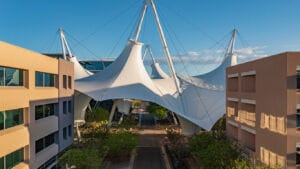In Arizona, major sporting events are transforming cities like Phoenix by boosting hotel revenue, driving infrastructure investment, and reshaping regional development. These events—ranging from the thunderous races at Pimlico Race Course to the energy of March Madness and the iconic Kentucky Derby—not only attract fans but also generate lasting economic and urban impacts. Held throughout the year, these gatherings bring together athletes, spectators, and businesses, creating momentum that extends well beyond stadium walls. By leveraging both historic and modern competitions, Phoenix is redefining how and why cities use sports to fuel long-term growth and evolution. When these events occur, the financial and cultural benefits ripple across the region, proving their influence extends far beyond game day.
Events That Shape Regions
The Preakness Stakes, hosted each year at Pimlico Race Course in Baltimore, remains one of the most iconic events in American horse racing. As the second jewel of the Triple Crown, it consistently captures national attention and brings a wave of activity to the local economy. Its rich heritage continues to serve as a point of pride for the city, with ongoing discussions about future enhancements aimed at preserving its legacy and expanding its role in community development.
Likewise, the Kentucky Derby at Churchill Downs in Louisville has evolved into a nationally celebrated experience, supported by reinvestment that enhances tourism and brand presence each year. Events like March Madness, which rotate across host cities, bring significant visibility and stimulate local economies through increased travel, hotel bookings, and venue upgrades. These examples show how major sporting events can spark both short-term excitement and long-term value.
Arizona has embraced this approach—and built upon it—by creating a full calendar of high-impact events that consistently support regional growth and infrastructure planning.
Arizona’s Year-Round Sports Economy
Where other states build around one tentpole event, Arizona has designed an entire calendar. The state has hosted the Super Bowl, NCAA Final Four, WM Phoenix Open, NASCAR Cup Series, and Cactus League Spring Training, among others. Each draws national or international audiences—and each contributes to a repeatable formula of economic growth.
The 2023 Super Bowl, played at State Farm Stadium in Glendale, generated an estimated $1.3 billion in total economic activity. Crucially, the benefits weren’t limited to Glendale. Cities like Phoenix, Tempe, and Scottsdale saw elevated hotel occupancy, increased restaurant demand, and extended visitor stays. These ripple effects are part of what makes Arizona’s approach so sustainable: it’s not just about hosting, it’s about activating an entire region.
Infrastructure That Keeps Delivering
Arizona’s success rests on more than warm weather and venue capacity. It’s about infrastructure that continues to serve long after each event. Downtown Phoenix has grown around major venues like Footprint Center and Chase Field, creating a walkable core that attracts both locals and tourists. The addition of light rail, public art spaces, and mixed-use developments ensures that stadiums aren’t isolated—they’re integrated.
In Glendale, the synergy between State Farm Stadium, Desert Diamond Arena, and the Westgate Entertainment District showcases a master-planned approach. These spaces support year-round concerts, expos, and sporting events. They’ve become lifestyle destinations, not just game-day attractions.
Creating Identity Through Consistency
Arizona doesn’t just want to be a sports destination—it’s working to be the best one. The WM Phoenix Open, known for its electric 16th hole and fan-driven energy, pulls in over 700,000 visitors annually. Spring Training draws loyal fans from across the country for weeks at a time. Combined with high-profile events like the UFC, WNBA All-Star Game, and the upcoming FIFA World Cup, Arizona offers consistent visibility across multiple demographics.
This steady cadence of events establishes a predictable urban rhythm. Businesses can plan for growth, city leaders can time their investments strategically, and residents come to view these moments as sources of civic pride and cultural vitality. It’s a model that successfully blends community engagement with economic opportunity—something many legacy events often struggle to achieve.
Evolving Fan Experiences and Arizona’s Digital Edge
Legacy events like the Preakness Stakes, held each May at Pimlico Race Course, continue to captivate national audiences. What once centered on grandstand tradition has expanded into a multi-platform experience where fans across the country follow contenders, track live race updates, and engage with expert commentary online. The digital transformation has made events like the Preakness more accessible—and more interactive—than ever before.
Arizona understands the value of this shift. While it doesn’t host the Preakness, the state has leaned into a similar model by designing venues and fan zones that support modern, connected experiences. From real-time stat integrations to mobile apps and streaming activations, the goal is to enhance how fans engage—whether they’re on-site or following from across the country.
Reputable online sportsbooks like FanDuel.com have also become part of how fans interact with nationally televised races such as the Preakness. These platforms provide an additional layer of participation through betting and the latest news. This enables fans to feel more immersed in the outcome and culture of the event—even from afar.
The Role of Climate and Geography in Arizona’s Advantage
While strategy and infrastructure drive much of Arizona’s sports economy, geography plays a quiet but crucial role. The state’s dependable weather—especially during the winter and early spring—makes it a reliable host for outdoor events that would face delays or cancellations elsewhere. This climate advantage is a key reason why the Cactus League draws 15 MLB teams and tens of thousands of fans each year. It’s also why Arizona regularly lands events like the Fiesta Bowl, College Football Playoff games, and high-attendance golf tournaments.
Beyond the sunshine, Arizona’s central location among major Western markets like California, Texas, and Colorado makes it accessible for both fans and teams. This connectivity reduces logistical friction and makes Phoenix an appealing stop on the national events circuit. The proximity to airports, resort-style accommodations, and scenic landscapes also enhances its desirability for event organizers aiming to offer more than just a venue.
In short, Arizona’s rise isn’t only due to planning—it’s geography aligned with vision. And as the state continues to sharpen its role as a year-round destination, that combination will remain a competitive edge.
The Model Other Cities Are Watching
What makes Arizona’s approach noteworthy is that it doesn’t rely on nostalgia. While cities like Baltimore and Louisville have successfully leveraged heritage, Arizona shows that growth is most sustainable when tied to volume, variety, and vision. Rather than resting on one iconic event, it multiplies the impact through frequency and diversity.
This model has implications far beyond state lines. Cities with ambitions to host high-profile events—from college championships to international tournaments—are watching how Arizona handles logistics, media, and community integration. The state’s infrastructure, reputation, and results suggest a blueprint that others may try to follow.
From Pimlico’s storied track to Phoenix’s modern stadiums, the message is clear: sporting events are no longer one-off opportunities. In the right hands, they’re city-shaping assets.




